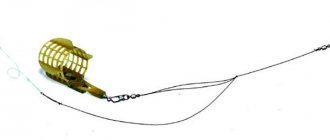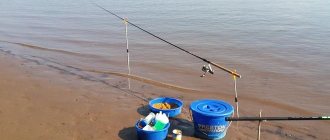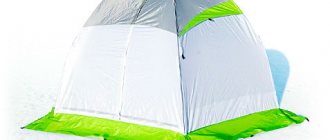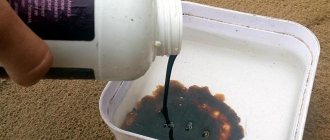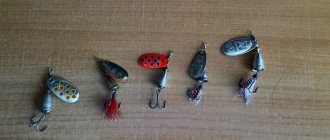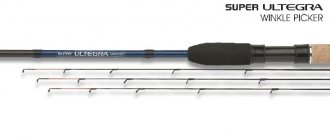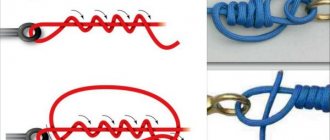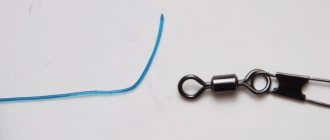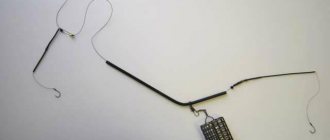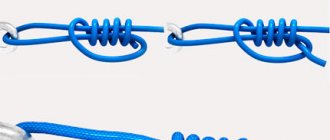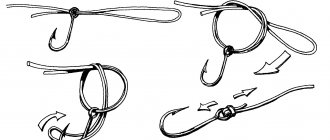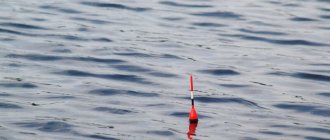What is Gardner's loop
In short, this is a reliable, simple and unpretentious loop. Gardner feeder loop is a solution for shallow and medium depths. The knot can be classified as “surgical” or self-tightening (Figure 1).
Gardner's modernized loop is called the "Paternoster". Feeder tackle performs two roles - a decoy and a hook. Due to the fixed feeder, it attracts prey, and the fish is caught on a sharp hook.
The feeder fishing scheme is attractive because you don’t need to put in unnecessary effort, and you can expect a good catch with peace of mind.
Figure 1. A special feeder loop was created by an amateur fisherman
The author of this knot is Steve Gardner, a famous angler using passive methods. How did he come up with the idea of creating this node?
Gardner loop for feeder - how to knit and use
The Gardner Loop Feeder is the gimmick that most feeders start with due to its ease of tying and effectiveness. Some anglers confuse this device with the classic paternoster. This is partly true, the gardener's paternoster is a variation of several of these devices.
The main problem for beginners is twisting the leash around the main line or catching it while casting. However, if installed correctly, such problems do not arise. In this article, we will examine in detail the specifics of installing a gardener’s paternoster and the nuances of its use for feeder fishing.
Feeder equipment
A Gardner loop for a feeder can be knitted on a pond in just a few minutes. Does not require special units or additional fishing accessories - the main fishing line and the fisherman’s hands. That is why this mount is popular among anglers. However, the gardener's paternoster is not universal - it is just one of several effective types of bait equipment.
A jig-gardner works better in a variety of fishing conditions, an asymmetrical loop in others, and a linear feeder assembly in a third. The angler's job while fishing is to figure out what works best under those particular conditions. Therefore, it is very important to master all the basic elements of feeder equipment. Article number of feeder equipment:
Advantages and disadvantages
There are no absolute nodes - they have both advantages and disadvantages. This is balanced by the functionality of various types of knots - for tying a hook, attaching a leash, sinkers (Figure 2).
Figure 2. The advantage of the design is the simplicity of knitting and the strength of the connection
The loop design provides a high level of sensitivity, but it is unknown whether the Gardner loop can compete with an asymmetrical loop in a strength chamber.
The list of advantages includes:
- Easy knitting - five minutes and you're done;
- The equipment can be used both in standing water and in running water;
- Omnivorous to the bottom surface: viscous silt, grass, snags - the hook with bait will always be on the surface;
- High sensitivity;
- The loop is also unpretentious in terms of fixation - you can do without an anti-twist and metal bends
- The use of monofilament or braid does not particularly affect the performance characteristics of the Gardner knot;
- Reliability of equipment and the need to use only one swivel;
- Low tangle and loop overlap.
Of the minuses, it should be noted that the fish can bend around the location of the bait, and when using monofilament, wear on the bends increases.
What kind of installation, its pros and cons
For fishing with a feeder, fishing rods equipped with a quivertip are used. A fish bite will be immediately noticeable to the fisherman. One of the main features of the paternoster is that the fish hooks itself with this type of installation.
Knitting a paternoster is carried out as follows:
- The main line must be folded in half.
- Stepping back from the edges by 15-20 cm, make a knot.
- The resulting loop is cut so that one end is one third higher than the other.
- A feeder feeder is attached to the short end, and a leash with a hook is attached to the long end.
General principle of installation of paternoster equipment
The method presented here illustrates the basic principle of the paternoster device. There are various knitting methods, which are outlined below.
The strengths of this equipment are as follows:
- Such feeder gear can be equipped directly on the shore of a reservoir.
- Manufacturing takes only a few minutes, and does not require the use of any complex devices.
- The paternoster makes it easy to see the bite on the quiver tip and feel it while holding the rod.
- When biting, in a significant number of cases, self-hooking occurs.
This fishing method has the following disadvantages:
- The presence of a braid of fishing line (used in several versions) is noticeable to the fish. If she's careful enough, this will scare her away.
- When connecting to the feeder, the line may fray.
- If you fish in a strong current, the sensitivity during the bite decreases.
- When the tackle is thrown over a long distance, there is a high probability of overlap.
Despite the difficulties of application, the popularity of this fishing method is growing.
Using feeders
A properly selected feeder will help you squeeze everything out of the loop. In a good way - it should not be too weighty; if possible, lighten the feeder as much as possible. This can be done using foam rubber or cutting off parts of a lead sinker.
It is useful to replace the feeder with a spoon sinker during the spring bite; in this case, feeding will not do a bad job, and the fish will be willing to take the hook.
There are different variations of feeders - with two hooks at the ends with fastening on the main fishing line or before the start of the Gardner loop.
What kind of fish is most often caught using the paternoster (Gardner's Loop)?
Most often, the paternoster is used when catching fish species such as carp, carp, bream, tench, crucian carp and some others. This is due to the fact that this equipment is well suited for fishing from the bottom in reservoirs with standing water or with a slight current, as well as with a muddy or uneven bottom. The Gardner loop can also be used in areas of reservoirs with complex bottom topography, for example, rocky ones.
The Gardner loop has a number of advantages over other types of equipment. Among the main ones are the following:
- Simplicity and speed of production. It takes literally 2-3 minutes to make the equipment. By the way, learning how to take it is not difficult and takes a minimum of time.
- High sensitivity. Thanks to the features of this paternoster described above, it is possible to achieve a high level of the gear itself - especially if you use light weight feeders.
- No overlaps.
- Although the equipment is not self-hooking, the chances that the fish can hook itself are very high. Due to the fact that the Gardner loop is installed on the main line, as well as its versatility, it is likely that the fish will be able to hook on its own, and this despite the fact that the paternoster does not belong to the classic self-hooking fishing equipment.
- There is no need to use additional swivels and other means. Thanks to its design features and simplicity, the paternoster does not need to install additional swivels and third-party items.
- Possibility of the most convenient modernization. To effectively catch fish in different conditions, upgrading your gear may often be necessary. For example, it depends on the strength of the current, the type of bottom soil, depth, and the need for long casting. The use of this equipment allows you to do a variety of manipulations with it, including modernization at the fishing site and, most importantly, as quickly and efficiently as possible. You should always have additional parts in stock - this will make your fishing as efficient as possible.
- Versatility. This is achieved through the use of long leashes and light feeders, and on reservoirs with complex bottom topography and rocky bottom, a paternoster on a snow leader is ideal. It can also be recommended in difficult fishing conditions and even in reservoirs with a serious and very noticeable current.
- No serious flaws.
Types of loops and knitting pattern
This is a simple variation of the feeder fishing loop, requiring a minimum of movements (Figure 4).
A diagram of how to weave a Gardner loop with your own hands:
- The basis is installation for the main part of the fishing line. Take a reel and rewind half a meter;
- Make a figure-of-eight loop on the fishing line with a total length of at least 10 cm;
- Thread the tail of the loop into the swivel mount;
- Connect the feeder to this structure;
- On the other edge of the structure, make another figure eight knot and secure the leash.
Figure 4. Connection tying diagram.
The method of attaching the entire equipment to a separate swivel is also being considered. The argument “against” is that it will cause visual clutter, and the gear will lose confidence among shy fish.
How to knit the Paternoster Gardner rig
The paternoster rig can be tied using just one figure-eight knot, creating a loop 20 cm long, onto which you can then attach the feeder using the cape method, but there is a more reliable and effective method - using twisting. See photos of paternoster equipment with twisting:
Step-by-step instructions for tying and equipping a feeder with a paternoster
- A piece of fishing line is folded in half and twisting begins with an ordinary braid. You can achieve a twist in two simple ways: a) secure a loop in your teeth and start twisting the twist with your hands, b) take the two ends of the fishing line and start twisting both fishing lines in the same direction.
- As soon as you have a 20 cm twist, make a figure eight knot, this will allow you to secure the twist very tightly and not unravel, stretch, or unwind.
- It is necessary to make another twist 10 cm long from a piece of fishing line, which is shown in the picture on the left (10 cm).
- Then the second twist and the fishing line on the right must be tied with an additional knot, placing both sections next to each other. This will allow the twist to point up or to the side rather than down. In this way, the twist will move the long leash away from the feeder (which is why the twist is needed).
- After all the loops of the paternoster are completely tied, you can insert the feeder and start feeding. Attaching the feeder is done using the cape method. The loop is inserted into the eye of the feeder, fully extended and placed over the body of the feeder. Then the line is tightened and the feeder is tightly secured in the loop.
- The leash with the hook is attached at the very last moment, when the starting feeding of the fishing point has been made (according to the feeder method, this is from 7 to 15-20 casts of the feeder with food to the fishing point). The simplest method by which you can attach a leash to a rig is a loop-to-loop knot.
The equipment can be modified by increasing the length of the second twist from 10 to 30 cm. Thus, the twist with the leash and hook will in any case hang below the feeder and will definitely not overlap or get tangled with the twist of the feeder, due to the elastic nature of the twist.
LNG operation in still water and weak currents
Naturally, the pre-tension of the main line on such water will be much less, and the feeder whip should be softer. After all, in still water you can fish with about zero preload of the main line, and even with a slight sag, when there is no preload at all.
The displacement of the tip of the feeder whip remains exactly the same as when fishing in medium and strong currents, however, the pulling forces have become so small that even small fish can do it. Even in “direct” bite transmission (when the transmission coefficient has become = 1), the pulling forces are quite surmountable for the fish.
Do-it-yourself tackle installation
It is extremely easy to knit a paternoster with your own hands, even on the spot, right next to a pond. The equipment gained its popularity due to a certain versatility in use. That is, it is good for both long and close casts, both on the current and in still water.
How to make a Paternoster correctly? The diagram is below.
Paternoster
Required items:
- Twisting;
- Swivel;
- Fluorocarbon line;
- Braided 0.1-0.14 mm;
- Closed / semi-closed feeder with a load (obviously loaded) 100-120 grams for current, 40-100 for standing water.
Installation
Make it a rule, on every fishing trip, the first thing you do is...
The entire tackle is connected to the main line using a “Loop to Loop” connection. Make a loop using a surgical knot.
The main line of the rig (0.3 mm) goes to the twisted connection. One part of the twist goes to the feeder, the other to the leash. The length of the twist to the feeder is 20 cm. To the leash – 10 cm.
The feeder is attached to the twist with a swivel and a carabiner, or a wrapping loop. The twist going to the leash is also attached through the “Loop to Loop” connection. The length of the leash is 50-100 cm. The leash is connected to the hook with a Sliding Snood, if the hook does not have a loop, or with a Double Palomar, if the hook has a loop. You can use two hooks when an additional hook is also attached to the twist. However, this will not be a classic Paternoster, but a modernized one.
Do not try to connect the fishing line and the leash by burning, otherwise a break is inevitable.
Gardner's loop
The Gardner Paternoster rig differs from the classic one in that it has a sliding loop, which reduces the chance of tearing and overlap.
Required items:
- Twisting;
- Swivel;
- Fluorocarbon line as a leader, 0.14-0.22 mm;
- Braided 0.1-0.14 mm;
- Closed/semi-closed feeder.
The equipment is attached to the main line with a surgical loop. You tie a 20-30 cm loop to the feeder, the feeder is fixed in the middle of this loop using locking beads or rubber bands. Then, using a loop-to-loop connection, the main line is connected to the leader. The leash is made of fluorocarbon, 0.14-0.22 mm. The hook is attached with a Snood or Double Palomar.
Installation of Paternoster Gardner according to Fadeev, video
Fadeev described in detail the structure of Paternoster's tackle.
Gardner's sliding paternoster
Few people know, but a sliding Paternoster is a possible option. Place the stopper on the leash side only, using stopper beads or elastic. Then comes the twist, the end of which is attached to the leash using a loop-to-loop connection. The twist can be replaced with a feedergum rubber band, this will increase the sensitivity of the tackle.
The sliding rig is attached to the main line using a carabiner or loop-to-loop connection. Then comes a fishing line 30-40 cm long. A feeder is attached to the fishing line through a swivel, and immediately after it a stopper. After this there is a twist of 10-15 cm or a feeder. The leash is made of fluorocarbon, 50-100 cm long
Read Alligator Pike
It is important to use leashes of faded colors, such that they do not catch the fish’s eyes. The feeder is attached to the fishing line with a swivel and carabiner
Knots for spinning lures
For spinning lures, hook knots that are not tied around the shank are suitable:
- Palomar;
- stepped;
- “Clinch” (grabbing) and double “Clinch”;
- deaf (cape method);
- "Shark's";
- "Crawford"
- Twisted Dropper Loop;
- Scaffold Knot;
A double stevedoring knot for attaching various baits when fishing with a spinning rod, this knot is ideal. 100% - its reliability.
Read How to cook spring mackerel
“Eight” is the simplest knot for creating a loop, into which you can then insert any bait using the cape method. This makes it very convenient to change bait from one to another.
Uni-knot is also very strong and easy to tie.
Uni-knot is also very strong and easy to tie. A knotless connection for spinning lures is a fastener that does not spoil the play of the bait and firmly attaches it to the braid.
How to deal with beards on braided fishing line - no more tangling of braided line. Spaced spinning rigs: Moscow, drop-shot.
